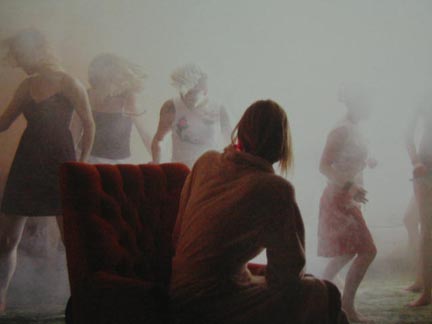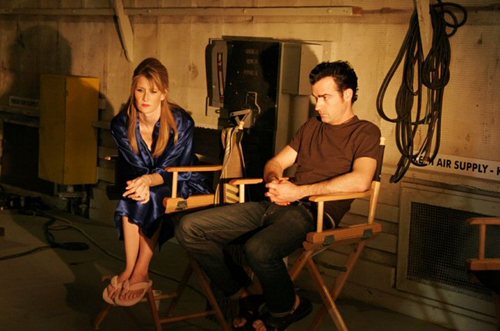April 20, 2007
Something got out from inside the story: Lynch's unhome videos
(Provisional thoughts on INLAND EMPIRE, based on one viewing - and once, in this case, is most certainly far from enough...)
Lynch's INLAND EMPIRE is full of holes.
A hole cigarette-burned into silk; a hole in the vagina wall leading to the intestine; a hole punctured into the stomach by a screwdriver; rabbit holes; holes in memory; holes in narrative: holes as positive nullity, gaps but also tunnels, the connectors in a hellish rhizome in which any part can potentially collapse into any other.
Both the cigarette burn hole and the hole in the vagina wall could serve as metonyms for the film's entire pyschotic geography. The hole in silk is an image of the camera and its double the spectating eye, whose gaze in INLAND EMPIRE is always voyeuristic and partial (we would see nothing if it weren't for the hole, yet what is behind the silk screen?) The hole in the vaginal wall, meanwhile, suggests a botched and demented Artaud-surgery aimed at transforming the organism into holey space. Holes within holes.

The best readings of INLAND EMPIRE have rightly stressed the film's labyrinthine, rabbet-warren anarchitecture. Yet the space involved is ontological, rather than merely physical. Mulholland Dr was perhaps the most compelling cinematic presentation to date of what Douglas Hofstadter calls a 'tangled hierarchy': a breaching of the distinction between ostensibly embedding and embedded ontological levels. With INLAND EMPIRE, world-haemorrhaging has become so accute that we can no longer talk about tangled hierarchies but a terrain subject to chronic ontological subsidence. 'Something got out from inside the story', we are told of the Polish movie which INLAND EMPIRE's film-within-a-film is remaking. In INLAND EMPIRE - which often seems like a series of dream sequences floating free of any ostensible reality, a dreaming without a dreamer (as all dreams really are) - no frame is secure, all attempts at embedding fail.
Each corridor - and there are many of Lynch's signature corridors in INLAND EMPIRE - is potentially the threshold to another world. Yet no character - the word seems absurdly inappopriate when applied to INLAND EMPIRE's fleeting figures, figments and fragments - can cross into these other worlds without themselves changing their nature. In INLAND EMPIRE, you are whatever world you find yourself in.

Reviews have confidently proclaimed that certain characters are 'prostitutes' or 'actresses'. Yet such rigid designations have little purchase on INLAND EMPIRE's vertiginous slippages, in part because the film continually prompts the questions: what is an actress? What is a prostitute? The short answer is that both actresses and prostitutes are (only) what they are for others. If INLAND EMPIRE insists upon the reversibility of the role of whore and actor - the prostitute is an actress, the actress is a prostitute - it is because in its worlds (as in ours), the condition of the actor-whore is universal: I AM WHAT I AM PAID TO BE. In the midst of one of the film's most disturbing sequences, shot, appropriately, on Hollywood Boulevard - Laura Dern - who may at this point be film star 'Nikki Grace' or film-within-a-film character 'Susan Blue' or Nikki Grace possessed by Susan Blue , (or ....) - declares 'I'm a whore', and her tone suggests hysteria, but also ecstasy and relief, as if the discovery has finally resolved her ontological inconsistency: So THAT'S what I am.
'Reflexivity without subjectivity', that perfect description of the unconscious, is exceptionally apt for INLAND EMPIRE's convolutions and involutions. Nikki Grace and the gaggle of other personae which Dern plays/ Grace hosts (or fragments into) put one in mind of the de-pyschologized avatars in Robbe-Grillet's novels - deprived of interiority, Nikki is a hole that we cannot help treating as an enigma, even though it is clear (to us, if not to her) that there is no hope of any solution. (Another question the film worries away at is the function of the proper name. What is to name something? So long as something has physical continuity are we justified in using the same name for it?) The temptation to ascribe depth, to resolve the film's ontological conundra epistemologically and psychologically (i.e. to attribute the film's to phantasms issuing from the deranged mind of one of the characters) is no doubt great, but must be resisted if we are to remain true to what is singular about the film. It is the film that is mad, not the characters in it.

As with Mulholland Dr, we are left with the impression that in INLAND EMPIRE it is Hollywood itself that is dreaming. Sunset Boulevard is one of INLAND EMPIRE's intertexts, and there's something both fitting and ironic about the fact that Lynch's latest meditation on 'the dream factory' should have been shot on Digital Video.
My fear before seeing INLAND EMPIRE was that Lynch's vision would dissipate in Digital Video's harsh and unforgiving light, its anti-expressionistic flatness. If anything, however, Lynch's sensibilty not only survives Digital Video, it reaches a new pitch through the use of the medium. This is in part because the use of Digital Video connotes reality: we are accustomed to seeing Digital Video used for home movies, for videos uploaded onto YouTube, for local news; its signature is the suggestion of minimal mediation. To see Lynch's worlds captured on digial video makes for a bizarre short-circuiting: as if we are witnessing a direct feed from the unconscious. In the age of YouTube and the cameraphone, all the world really is a film set. With INLAND EMPIRE, Lynch has produced a horror film for this culture of ubiquitous filming. (It becomes possible to imagine a future Lynch movie entirely filmed on a mobile phone.)
A word, also, for INLAND EMPIRE's brilliant 'sound design', by Lynch himself. The sound in INLAND EMPIRE - including an audacious and extensive deployment of Penderecki, which cannot but be heard as a quotation from The Shining - is superb throughout. I would definitely include in this - and here is the one point at which I find myself at variance with American Stranger's excellent piece on IE - the final sequence, which uses Nina Simone's 'Sinnerman'. Far from finding this sequence 'infuriatingly cute', it seemed to me like an infernal version of Dennis Potter - Pennies in Hell, perhaps.
Posted by mark at April 20, 2007 04:17 PM | TrackBack